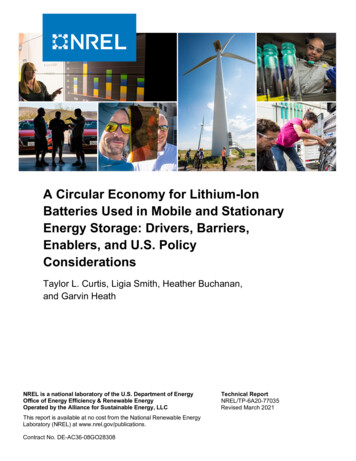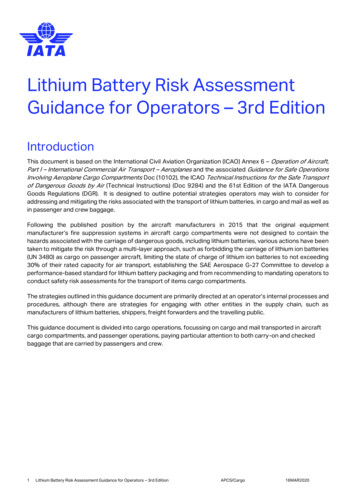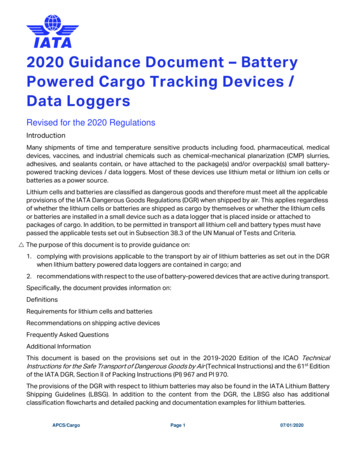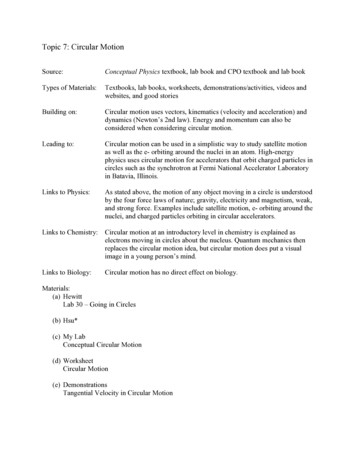
Transcription
A Circular Economy for Lithium-IonBatteries Used in Mobile and StationaryEnergy Storage: Drivers, Barriers,Enablers, and U.S. PolicyConsiderationsTaylor L. Curtis, Ligia Smith, Heather Buchanan,and Garvin HeathNREL is a national laboratory of the U.S. Department of EnergyOffice of Energy Efficiency & Renewable EnergyOperated by the Alliance for Sustainable Energy, LLCThis report is available at no cost from the National Renewable EnergyLaboratory (NREL) at www.nrel.gov/publications.Contract No. DE-AC36-08GO28308Technical ReportNREL/TP-6A20-77035Revised March 2021
A Circular Economy for Lithium-IonBatteries Used in Mobile and StationaryEnergy Storage: Drivers, Barriers,Enablers, and U.S. PolicyConsiderationsTaylor L. Curtis, Ligia Smith, Heather Buchanan,and Garvin HeathSuggested CitationCurtis, Taylor L., Ligia Smith, Heather Buchanan, and Garvin Heath. 2021. A CircularEconomy for Lithium-Ion Batteries Used in Mobile and Stationary Energy Storage:Drivers, Barriers, Enablers, and U.S. Policy Considerations. Golden, CO: NationalRenewable Energy Laboratory. sti/77035.NREL is a national laboratory of the U.S. Department of EnergyOffice of Energy Efficiency & Renewable EnergyOperated by the Alliance for Sustainable Energy, LLCTechnical ReportNREL/TP-6A20-77035Revised March 2021This report is available at no cost from the National Renewable EnergyLaboratory (NREL) at www.nrel.gov/publications.National Renewable Energy Laboratory15013 Denver West ParkwayGolden, CO 80401303-275-3000 www.nrel.govContract No. DE-AC36-08GO28308
NOTICEThis work was authored by the National Renewable Energy Laboratory, operated by Alliance for SustainableEnergy, LLC, for the U.S. Department of Energy (DOE) under Contract No. DE-AC36-08GO28308. This work wassupported by the NREL Planning and Assessment Circular Economy for Energy Materials Steering Committee. Theviews expressed herein do not necessarily represent the views of the DOE or the U.S. Government.This report is available at no cost from the National RenewableEnergy Laboratory (NREL) at www.nrel.gov/publications.U.S. Department of Energy (DOE) reports produced after 1991and a growing number of pre-1991 documents are availablefree via www.OSTI.gov.Cover Photos by Dennis Schroeder: (clockwise, left to right) NREL 51934, NREL 45897, NREL 42160, NREL 45891, NREL 48097,NREL 46526.NREL prints on paper that contains recycled content.
ErrataThis report, originally published in February 2021, has been revised in March 2021 to correct theauthors’ names and order; correct the spelling of a name and their affiliation in theacknowledgments section; correct grammatical errors; and provide clarification in certainsections of the report.
AcknowledgmentsWe gratefully acknowledge the National Renewable Energy Laboratory (NREL) Planning andAssessment Circular Economy for Energy Materials Steering Committee for its funding support.We also acknowledge John “Jack” Wadleigh and Anabelle Chaffin of NREL for their researchsupport. And we thank the following report reviewers for their time and expertise: KristenArdani, Doug Arent, Dan Bilello, Nate Blair, Wayne Hicks, Mike Meshek (editor), and GianPorro of NREL; Ken Boyce, UL; Kathy Lett, U.S. Environmental Protection Agency (EPA),Headquarters; Daniel Stoehr, Daniels Training Services, Inc.; David Wagger, Institute for ScrapRecycling Industries; Stephanie Shaw, Electric Power Research Institute; Jordan Rivera and NealSuchak, U.S. Department of Transportation, Headquarters; and Jessica Citrola, North CarolinaDepartment of Environmental Quality.We also thank the following for their time and expertise: Charles (Chuck) Figur, U.S. EPA,Region 8; Chris Newman, U.S. EPA Region 8; Lia Yohannes, U.S. EPA, Headquarters; AmandaCotton and John Gilkeson, Minnesota Pollution Control Agency; Jennifer Martin, IllinoisSustainable Technology Center; Anthony (Tony) Burrell, and Maggie Mann, NREL; JonWeisman, (formerly) Tesla; Laura Allerston, Aceleron Energy; Paulina Kolic, and Teresa Bui,CalRecycle; and Carl Smith, Call2Recycle.iiiThis report is available at no cost from the National Renewable Energy Laboratory at www.nrel.gov/publications.
List of LAmerican National Standards Institutebattery energy storageCalifornia Environmental Protection AgencyU.S. Department of EnergyU.S. Department of Transportationend-of-lifeEnvironmental Protection Agencyelectric vehicleInternational Air Transport AssociationInternational Building CodeInternational Civil Aviation OrganizationInstitute of Electrical and Electronics EngineersInternational Maritime Dangerous Goodskilogramlithium-ion batterylithium-ion battery energy storagemetric tonsNational Electrical CodeNational Fire Protection AssociationNational Renewable Energy LaboratoryOrganization for Economic Cooperation and Developmentphotovoltaicresearch and developmentResource Conservation and Recovery Act of 1976Solar Energy Industries Associationtreatment, storage, and disposal facilityUnderwriters LaboratoriesivThis report is available at no cost from the National Renewable Energy Laboratory at www.nrel.gov/publications.
Executive SummaryLarge-format lithium-ion batteries (LiB) are an essential component to a zero-carbon energytransition in the United States and around the world. National and international policy focused onreducing carbon emissions and increasing electric grid resiliency continue to drive demand formobile and stationary LiB battery energy storage (BES) (BNEF 2020; Wood MacKenzie andESA 2020). In the U.S. alone, stationary BES (to support renewable energy generation) isexpected to grow from 523 megawatts annually to 7.3 gigawatts in 2025, and U.S. roads areprojected to see 46 million passenger electric vehicles (EV) by 2035 (BNEF 2020; Wesoff 2020;Wood MacKenzie and ESA 2020).The rapid growth and expected continual demand for mobile and stationary lithium-ion BES (LiBES) has led to global environmental and supply chain concerns. Critical materials (e.g., cobalt,lithium, nickel, graphite, manganese) used in LiBs are finite and mined in only a few regionsaround the world. Moreover, they are often found and refined in countries with less-stringentenvironmental and human health regulations. The demand for graphite, lithium, and cobalt isexpected to increase by nearly 500% by 2050 and experts expect a shortage of nickel within in 56 years if current trends for mobile and stationary Li-BES persist (World Bank 2020; Mayyas,Steward, and Mann 2019; ReCell Center 2019c).Moreover, as BES capacity increases in the United States so will the volume of spent LiBs (Bade2019). Estimates based on a 10-year lifetime assumption found that the volume of LiBs that havereached the end of their utility for EV applications alone could total two million units (fourmillion metric tons) annually by 2040 in the United States (Richa et al. 2014; Ai and Borucki2018). Retirements that are due to early failure (e.g., crashes and battery replacements), as wellas BES deployment beyond earlier expectations, will increase these projections (Gibson 2019;Ai and Borucki 2018; Richa et al. 2014).As first-generation EV batteries reach end-of-life in the U.S. and the global demand for criticalLiB materials increases U.S. industry stakeholders, regulators, and policymakers are starting to(1) consider solutions to drive and enable environmentally sustainable LiB managementdecisions and behaviors and (2) identify barriers to a circular economy for LiBs. Circulareconomy principles attempt to transition from a “take-make-consume-dispose” linear economicsystem to a circular system that allows for the long life, high performance, and thereuse/recovery of products and materials (Ellen MacArthur Foundation 2016).In this report we analyze drivers, barriers, and enablers to a circular economy for LiBs used inmobile and stationary BES systems in the United States. We also analyze federal, state, and locallegal requirements that apply to the reuse, recycling and disposal of LiBs as well as the legalliability associated with noncompliance. Finally, we provide an overview of policies andinitiatives in the United States that expressly address reuse/recovery and disposal of large-formatLiBs. Some of our findings are listed below:Drivers of a Circular Economy for LiBsNew and expanded market opportunities, job creation, supply chain stability, and reducednegative environmental impacts are drivers for federal, state, and local investment in reuse andrecovery of LiBs. The secondary market for repurposed EV LiBs could include stationary andvThis report is available at no cost from the National Renewable Energy Laboratory at www.nrel.gov/publications.
mobile BES system applications as well as other applications that require less battery cycling(e.g., drones and forklifts) (Kelleher Environmental 2019; Engel, Hertzke, and Siccado 2019;Neubauer et al. 2015; Elkind et al. 2014). Existing domestic businesses (e.g., auto dismantlers,manufacturers, repair shops, mechanics, third-party recycling companies, and lifecyclemanagement companies) could expand to include LiB repair, recycling, handling, and transportservices. New companies could emerge to provide reuse and recycling products and services thatinclude 1) collection, transport, disassembly of the battery pack; 2) diagnostic and screening teststo identify battery chemistries; and 3) repair, refurbishment, reassembly, installation, recycling,reverse logistics, and resale. (Kelleher Environmental 2019). In addition, domestic recovery ofcritical materials (e.g., lithium, cobalt, nickel, manganese, and graphite) from LiBs could reduceU.S. dependence on foreign markets and imports and bolster domestic production andmanufacturing (ReCell 2019b; NREL 2019a; Jacoby 2019; Gaines 2018; Patel 2017; Elkind2014). Secondary use of LiBs can reduce disposal of reusable products, while recycling-basedresource recovery of LiBs could divert valuable materials from landfills (Salim et al. 2019;ReCell Center 2019a, 2019b; Argonne 2019; Jacoby 2019; NREL 2019a; Patel 2017; Elkind2014). Further, extending the useful life of LiBs through reuse lowers lifecycle environmentalimpacts by reducing energy output and the costs of obtaining, transporting and refining virginmaterials required to manufacture new LiBs (ReCell Center 2019a, 2019b; Salim et al. 2019).Cost savings, increased profits, and enhanced competitiveness are drivers to increase privateinvestment in product and process innovation and the reuse and recovery of LiBs. Manufacturersand system owners could sell used LiB packs to generate revenue or donate LiB packs forcharitable use and receive a tax credit. Manufacturers could lower manufacturing costs byreusing recovered materials from customer warranty returns, manufacturing scrap, and otherretired LiBs. System owners and third-party recyclers may also generate revenue by sellingrecovered materials into commodity markets (Salim et al. 2019; ReCell Center 2019b; Jacoby2019; ReCell Center 2019d; NREL 2019a; Xu et al. 2018; Patel 2017; Elkind 2014). Moreover,companies that engage in environmentally sustainable business practices such as reuse andrecycling may in turn increase consumer confidence in secondary market products, and theiroverall competitiveness in the marketplace (Salim et al. 2019; Xu et al. 2018).Barriers to a Circular Economy for LiBsThe reuse and recycling market for LiBs in the United States is nascent but there are limitedservices and infrastructure in place to support reuse and recycling of LiBs. Moreover, theinfrastructure, processes, and technology currently in place and available for the reuse andrecycling of LiBs are not optimized for efficient cost-effective reconditioning or recovery ofmaterials. As a result, reuse and recycling options in the United States are less readily availableand are more costly than cheaper, more accessible disposal options.There is also limited motivation or incentives for private investment in new and expanded BEScircular economy market opportunities. There is limited publicly available information and dataavailable regarding the value of, and markets for, reused and recovered LiBs to informinvestment decisions. The applicability of state and local interconnection, fire, building, andelectrical regulations to BES systems is often unclear, making it difficult to determine viablesecondary use applications. In turn there is limited publicly available information and projects todemonstrate the quality, performance, safety, and technical viability of reused and refurbishedviThis report is available at no cost from the National Renewable Energy Laboratory at www.nrel.gov/publications.
LiBs which may also impact consumer trust and confidence in the reuse of LiBs for mobile andstationary application. Moreover, federal and state solid waste and federal transportation lawsoften regulate LiBs destined for resource recovery in the same manner as LiBs destined fordisposal, which does not provide an incentive for recycling especially when the economics andaccessibility of disposal are more favorable.Enablers to a Circular Economy for LiBsPolicy 1 is needed to enable a circular economy for LiBs in the United States. Government fundedresearch and development (R&D) and analysis could enable private investment in the earlystages of new and expanded BES market opportunities by providing answers to questions thatcould help alleviate market uncertainty and lead to more efficient cost-effective technologies,processes and services for the reuse and recycling of LiBs. For example, vehicle diagnostic anddegradation data, as well as improved methods of monitoring batteries in the field could aid lifeexpectancy projections, which can be used to inform supply forecasts and help identify viablesecondary use applications. Policy can also mandate or incentivize the reuse and recycling ofLiBs, which is needed to enable sustainable material management practices for LiBs until themarket matures and the economics of reuse and recycling are more competitive with disposal.For instance, government subsidies, grants and awards could be used to reduce financial risk andmake early investment for private industry more desirable. Policies could also mandate reuse orrecycling or prohibit disposal and they could also incentivize reuse and recycling by reducing theregulatory burden and legal liability associated compared to disposal.Federal, State, and Local Legal RequirementsIn this report, we also analyze federal, state, and local legal requirements that apply to the reuse,recycling and disposal of LiBs as well as the legal liability associated with noncompliance. Ouranalysis of state and local interconnection, fire, building, and electrical regulations in the UnitedStates revealed that these regulations are often complex and vary by jurisdiction and typically donot explicitly address BES systems. Anecdotal evidence suggests the variability and ambiguityof how these regulations apply to BES systems has created uncertainty that may impact reuse ofLiBs for grid-tied and off-grid applications. We also analyze federal solid waste requirementspursuant to the Resource Conversation and Recovery Act of 1976 (RCRA) which may apply tolarge-format LiBs accumulated or stored before recycling or disposal and those being recycled ordisposed of. We found that large-format LiBs are often regulated as RCRA hazardous solidwaste or universal hazardous waste necessitating compliance with stringent generation, handling,storage, treatment, recycling, and disposal requirements which carry civil and criminal penaltiesfor noncompliance. Moreover, LiBs destined for resource recovery are often regulated in thesame manner as those being disposed, which does not provide a regulatory incentive to recycleLiBs. In addition, anecdotal evidence suggests that there is confusion and jurisdictionaldiscrepancies regarding whether certain reuse and recovery processes (e.g., cathode relithiation)for LiBs triggers RCRA regulation or not.We use “policy” in this report broadly to include not only federal, state, and local statutory and regulatoryrequirements but also government initiatives and goals.1viiThis report is available at no cost from the National Renewable Energy Laboratory at www.nrel.gov/publications.
LiB Material Management PoliciesFinally, we provide an overview of policies and initiatives in the United States that expresslyaddress reuse/recovery and disposal of large-format LiBs. We found no U.S. federal policies thataddress the reuse of or EoL management options for LiBs used in stationary and mobile BESapplication. North Carolina and California are the only U.S. states we found with policies thatdirectly address reuse and EoL management options for LiBs used in BES systems. NorthCarolina’s law requires state agencies to study and recommend policy regarding the reuse,recycling, and disposal of stationary energy storage system batteries. Similarly, California’s lawrequires the California Environmental Protection Agency to conduct a study and recommendpolicy to reach a goal of 100% reuse and recycling of EV LiBs. Hawaii also has proposed a billthat, if enacted, would require a comprehensive study to determine best practices for disposing ofand recycling clean energy materials, including batteries. In addition to the state law, Californiaalso has a state-led initiative in place to study EV and stationary BES decommissioning and EoLmanagement options. These recent policies may signal a growing trend to prioritize sustainablematerial management practices for early retired and EoL batteries used for stationary and mobileBES application.Our results are based on legal and literature-based research. In addition, our results incorporatefeedback and information we received from a series of interviews conducted throughteleconference and email exchange with a diverse group of mobile and stationary BES experts,including academic and research organizations, industry associations, LiB manufacturers, LiBreuse/repair/recycling companies, consultants, as well as U.S. federal and state regulators, andpolicymakers. The questions used in each interview were tailored specifically to the industrystakeholders’ areas of expertise. While this report addresses stationary and mobile LiBs, much ofthe information and experience with LiB reuse and EoL material management is derived fromincreased management of spent EV LiBs in the United States. Moreover, this report is limited toU.S. LiB-BES regulatory, policy, and market analysis.This report is intended to inform decisionmakers, including those involved with policy design;it does not endorse any particular policy mechanism over another, nor does it assess all regulatoryrequirements or the impacts that those requirements and policies may have on U.S. BES marketsor related commodity markets.viiiThis report is available at no cost from the National Renewable Energy Laboratory at www.nrel.gov/publications.
Table of Contents12Introduction . 1Drivers, Barriers, and Enablers to a Circular Economy for LiBs . 62.12.22.334Regulatory Considerations for the Reuse of LiBs . 223.13.23.33.4Interconnection Regulations . 22Fire and Building Regulations. 23Electrical Regulations . 24Industry Certification Standards. 244.1Regulation of LiBs as Solid Waste. 264.1.1 Materials Excluded from the Definition of Hazardous Solid Waste . 284.1.2 RCRA Hazardous Waste Determination . 29Regulation of LiBs as Hazardous Waste . 30Regulation of LiBs as Universal Waste . 30Comparison of Hazardous Waste and Universal Waste Handling, Storage, and TransportRequirements. 324.4.1 Generator and Handler Requirements . 324.4.2 Treatment, Storage, and Disposal Facility and Destination Facility Requirements . 34Transport and Export Requirements. 354.5.1 Highway and Rail Transport . 364.5.2 Air Transport . 374.5.3 Vessel Transport. 374.5.4 Export . 38Penalties for Noncompliance. 394.6.1 RCRA Hazardous and Universal Waste Regulations. 394.6.2 DOT Hazardous Materials Regulations . 40Statutory and Regulatory Considerations for the Reuse, Recycling, and Disposal of LiBs . 264.24.34.44.54.65State Policies . 415.15.267Drivers . 62.1.1 Economic Drivers. 72.1.2 Environmental Drivers . 9Barriers . 102.2.1 Technology, Infrastructure, and Process Barriers . 112.2.2 Information and Data Barriers. 122.2.3 Regulatory Barriers . 132.2.4 Economic and Market Barriers. 14Enablers . 152.3.1 Research, Development, and Analysis Enablers . 152.3.2 Information Availability and Exchange Enablers . 192.3.3 Economic and Market Enablers . 192.3.4 Regulatory and Policy Enablers . 205.3Enacted Policies . 415.1.1 California. 415.1.2 North Carolina . 42Proposed (Pending) Legislation . 435.2.1 Hawaii . 43State-Led Initiatives . 44Conclusion . 45References . 46Court Cases. 54Executive Orders . 54ixThis report is available at no cost from the National Renewable Energy Laboratory at www.nrel.gov/publications.
8Federal and State Statutes. 54Federal and State Regulations . 54International Treaties . 55State Session Laws . 55State Bills . 55State Historic Bills. 55Interviews . 56List of FiguresFigure 1. A circular economy for LiBs . 2Figure 2. State large-format battery material management policies (enacted, pending, and state-ledinitiatives). 41List of TablesTable 1. Drivers of a Circular Economy for LiBs. 7Table 2. Barriers to a Circular Economy for LiBs . 10Table 3. Potential Enablers to a Circular Economy for LiBs . 15Table 4. Regulatory Considerations for the Reuse of LiBs . 22Table 5. Statutory and Regulatory Considerations for the Reuse, Recycling, and Disposal of LiBs . 26Table 6. Federal Hazardous Waste Generator and Universal Waste Handler Requirementsa . 32Table 7. Federal Hazardous Waste Transporter and Universal Waste Transporter Requirementsa . 35xThis report is available at no cost from the National Renewable Energy Laboratory at www.nrel.gov/publications.
1 IntroductionThe global market for large-format lithium-ion batteries (LiB) 2 continues to grow in responseto increasing demand in electric vehicles (EVs) 3 and energy storage. From 2013 to 2020, totalcumulative U.S. energy storage deployments reached approximately 1,600 megawatts, of whichLiBs accounted for 99% of the total market share (Wood MacKenzie and ESA 2020; Bade2019). From 2011 to 2020, total cumulative U.S. passenger EV sales 4 reached approximately1.4 million units, of which LiBs accounted for most of the market share (BNEF 2020; DOE n.d.;Coffin and Horowitz 2018).State and federal policy focused on electric grid resiliency and on zero-emission energygeneration and transport will continue to drive the demand for mobile—and—stationary batteryenergy storage (BES) 5 in the United States (BNEF 2020; Wood MacKenzie and ESA 2020). TheU.S. energy storage market is expected to grow from an annual deployment of 523 megawatts in2013 to 7.3 gigawatts in 2025 (Wood MacKenzie and ESA 2020; Wesoff 2020). Rapid growth inthe U.S. passenger EV market is also projected to continue, and the deployment of commercialEVs is expected to gain momentum by 2030 (BNEF 2020). Annual passenger EV sales in theUnited States are forecasted to reach 1.1 million by 2025, and 4.0 million annually by 2030,which equates to 16 million units on U.S. roads by 2030 and 46 million by 2035 (BNEF 2020).LiBs are expected to continue to dominate the global market share for use in both mobile andstationary BES through 2035, and therefore lithium-ion BES (herein Li-BES or BES) is the focusof this report (BNEF 2020; Wood MacKenzie and ESA 2020; Mayyas, Steward, and Mann2019).As BES capacity increases in the United States, so will the volume of spent LiBs (Bade 2019).Estimates based on a 10-year lifetime assumption found that the volume of LiBs that havereached the end
There is also limited motivation or incentives for private investment in new and expanded BES circular economy market opportunities. There is limited publicly available information and data available regarding the value of, and markets for, reused and recovered LiBs to inform investment decisions.











